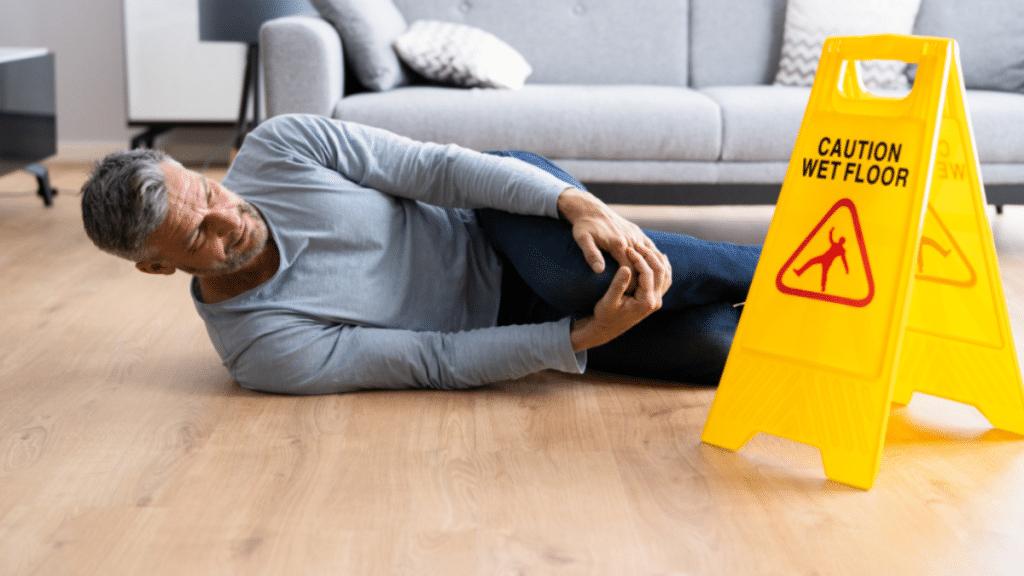Just imagine a situation where you’re browsing a boutique in Oklahoma City, humming along to overhead music, when splat-your feet fly out from under you. As you clutch your throbbing knee, the manager shrugs: “That wet floor sign was right there!” But here’s the twist: Oklahoma’s compensation rules for slip-and-fall victims are full of surprises most never see coming. Let’s decode them.
The Oklahoma Visitor Hierarchy: Why Your Reason for Being There Matters
In Oklahoma, your compensation hinges on one question: Why were you on the property? The law sorts visitors into three buckets, each with different rights:
| Visitor Type | Duty Owed | Real-World Example |
| Invitee | Fix hazards + regular inspections | Shopper in a grocery store |
| Licensee | Warn of known dangers | Guest at a backyard BBQ |
| Trespasser | No duty (mostly) | Someone cutting through a yard |
Key insight: A 2024 study found 68% of successful slip-and-fall claims involved invitees, as property owners face stricter duties for business visitors.
Pro tip: Even in “staff only” zones, look for implied invitations. Did you follow a “Restroom” sign? Courts often side with injured visitors in these gray areas.
The Compensation Menu: What You Can Actually Claim
Oklahoma lets victims recover two main damage types, plus a rare third:
1. Economic Damages: The Receipt-Based Payouts
These cover tangible losses with paper trails:
- Medical bills: ER visits, surgeries, even future treatments like physical therapy.
- Lost income: Missed workdays or reduced earning capacity if injuries linger.
- Property damage: Ruined phone, torn clothes, or broken glasses.
Example: A Tulsa teacher slipped on icy stairs, fracturing her wrist. Her $28,000 settlement included $15k for surgery and $13k for substitute teacher costs during recovery.
2. Non-Economic Damages: The “Pain Multiplier” Game
No receipts? No problem. Oklahoma recognizes invisible losses through two formulas:
| Method | How It Works | Best For |
| Multiplier | Medical bills × 1.5–5 (based on severity) | Broken bones, traumatic injuries |
| Per Diem | Daily rate × recovery days (e.g., $100/day) | Short-term sprains, minor burns |
Case in point: A chef who lost his sense of smell after a kitchen fall used the multiplier method. His $10k medical bills became $40k (4×) for lifelong sensory loss.
3. Punitive Damages: The “You’ll Regret That” Penalty
Reserved for property owners who act recklessly, like ignoring repeated warnings about a broken stairwell. Oklahoma caps these at $100k unless the misconduct was extreme.
The Fault Factor: How Oklahoma’s 50% Rule Can Wipe Your Payout
Oklahoma uses modified comparative negligence-a fancy term meaning:
If you’re >50% at fault, you get $0.
If you’re ≤50% at fault, your payout shrinks by your fault percentage.
Insurers love blaming victims for:
- “Distracted walking” (e.g., texting)
- Wrong footwear (flip-flops in rain)
- Ignoring warnings (even poorly placed signs)
Counterattack tactics:
- Photo evidence: Snap shoes showing treads, hazard locations relative to signs.
- Witness statements: “She wasn’t on her phone-she was looking at products!”
- Expert testimony: Biomechanical analysts can debunk “you should’ve seen it” claims.
2024 data: Plaintiffs who reduced their fault below 30% saw 89% higher payouts than those at 40-50%.
The Hidden Hurdles: Traps That Capsize Claims
The “You Waited Too Long” Time Bomb
Oklahoma’s statute of limitations gives two years to file claims-with exceptions:
- Minors: Clock starts at 18th birthday.
- Delayed discovery: Didn’t realize injuries were crash-related? Courts may extend deadlines.
Survival move: Send a preservation letter within days, forcing property owners to save security footage before it’s deleted.
The “Final Release” Fine Print
Sign too soon, and you’re stuck-even if injuries worsen. One victim accepted $20k for a “sprained ankle,” only to need $50k surgery months later. Always get a doctor’s clearance before settling.
The Settlement Math: Why $100k ≠ $100k
Your final check gets slashed by:
- Attorney fees: Typically 33–40% (unless flat-fee).
- Medical liens: Hospitals may claim part of your payout.
- Health insurance paybacks: Some policies demand reimbursement.
Hypothetical breakdown:
- Gross settlement: $100,000
- Minus 33% attorney fee: $33,000
- Minus $20k medical lien: $47,000 net
Pro tip: Negotiate liens before settling. Some hospitals accept reduced payments if paid promptly.
The Lawyer Leverage: How Attorneys Flip the Script
Hiring legal help isn’t just about paperwork-it’s strategy. In 2024, Oklahoma victims with lawyers received 3.1× higher payouts than those without. Here’s why:
- They speak “insurance adjuster”: Demand letters with phrases like “jury verdict history” and “punitive exposure” spark faster offers.
- They weaponize evidence: Day-in-the-life videos show your pain better than medical charts.
- They exploit insurer math: Companies track which firms go to trial. No courtroom experience? Expect lowballs.
Real win: A retiree tripped over unmarked construction debris. The first offer: $15k. Her lawyer found prior incident reports-settlement: $220k.
The Bottom Line
Oklahoma’s slip-and-fall compensation rules aren’t a mystery-they’re a maze. Property owners bank on victims getting lost in liability debates and fault percentages. But with the right map (aka evidence), you can navigate to fair payouts.
Think of it like a board game:
- Collect evidence tokens (photos, witnesses, logs).
- Avoid fault traps (fight every “you should’ve” claim).
- Land on the lawyer space (triple your compensation odds).
Remember: insurers have actuarial tables. You have pain diaries, medical scans, and Oklahoma’s unique damage categories. Play your cards right, and that “minor slip” could secure major relief.
Because in the Sooner State, the real magic isn’t avoiding falls-it’s knowing how to rise after them.
